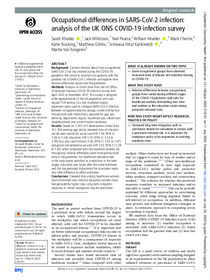Occupational differences in SARS-CoV-2 infection: analysis of the UK ONS COVID-19 infection survey

Rhodes, Sarah ; Wilkinson, Jack ; Pearce, Neil ; Mueller, William ; Cherrie, Mark P.C. ; Stocking, Katie ; Gittins, Matthew ; Katikireddi, Srinivasa Vittal ; van Tongeren, Martie
Journal of Epidemiology and Community Health
2022
Early View
1-6
epidemic disease ; occupational risks ; survey ; healthcare worker
Occupational risks
English
Bibliogr.
"Background
Concern remains about how occupational SARS-CoV-2 risk has evolved during the COVID-19 pandemic. We aimed to ascertain occupations with the greatest risk of SARS-CoV-2 infection and explore how relative differences varied over the pandemic.
Methods
Analysis of cohort data from the UK Office of National Statistics COVID-19 Infection Survey from April 2020 to November 2021. This survey is designed to be representative of the UK population and uses regular PCR testing. Cox and multilevel logistic regression were used to compare SARS-CoV-2 infection between occupational/sector groups, overall and by four time periods with interactions, adjusted for age, sex, ethnicity, deprivation, region, household size, urban/rural neighbourhood and current health conditions.
Results
Based on 3 910 311 observations (visits) from 312 304 working age adults, elevated risks of infection can be seen overall for social care (HR 1.14; 95% CI 1.04 to 1.24), education (HR 1.31; 95% CI 1.23 to 1.39), bus and coach drivers (1.43; 95% CI 1.03 to 1.97) and police and protective services (HR 1.45; 95% CI 1.29 to 1.62) when compared with non-essential workers. By time period, relative differences were more pronounced early in the pandemic. For healthcare elevated odds in the early waves switched to a reduction in the later stages. Education saw raises after the initial lockdown and this has persisted. Adjustment for covariates made very little difference to effect estimates.
Conclusions
Elevated risks among healthcare workers have diminished over time but education workers have had persistently higher risks. Long-term mitigation measures in certain workplaces may be warranted."
Digital
The ETUI is co-funded by the European Union. Views and opinions expressed are however those of the author(s) only and do not necessarily reflect those of the European Union or the ETUI.